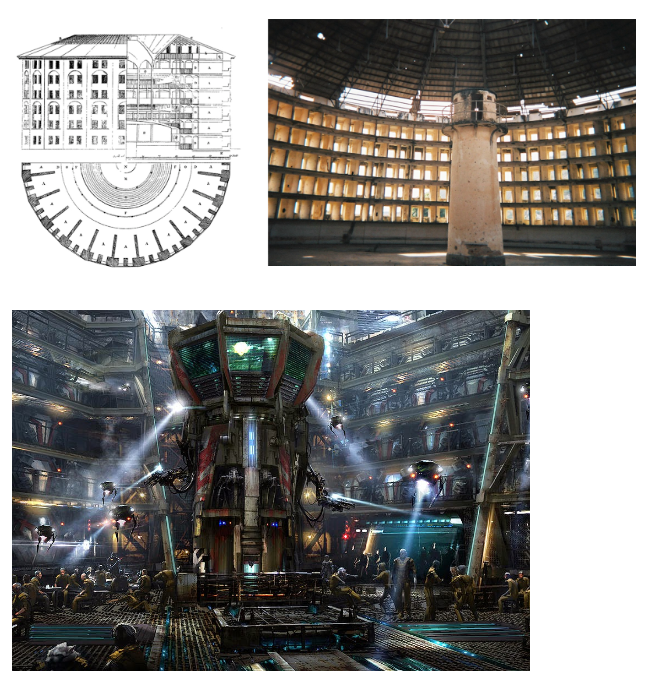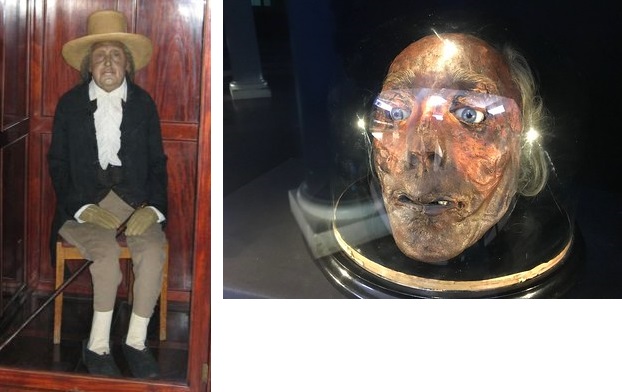3.3 Classical School of Criminology
As education, philosophy, and novel ideas spread through Europe during the Age of Enlightenment, the public became tired of the status quo and began heavily questioning the authority of the church. Many philosophers started arguing that humans were rational, thinking agents who possessed free will. This flew in the face of the church’s claim that bad behavior (crime) was often the result of demonic possession, not individual, rational thought and choices. This new way of thinking caused an uproar because if crime was the result of rational decision-making, it could not be solved through religious intervention. The existing system was falling apart, and a new system needed to be developed. It was in this setting that the classical school of criminology was established.
Philosophers, social reformers, and other major thinkers who gained popularity and prominence during the Age of Enlightenment believed that humans were reasoning beings who made decisions based on their own self-interest and rationality (weighing the pros and cons of their actions). Consequently, rational choice, individual agency, and free will are at the core of classical criminology. With these ideas in mind, they proposed new methods of addressing crime and a new system of justice.
The social contract was an important element of this new way of looking at people’s decision-making and behavior. The social contract, which is typically associated with theorists like Jean-Jacques Rousseau, Thomas Hobbes (1651) and John Locke, is a view of social order that claims society must voluntarily give up some of their personal freedoms in exchange for public safety as provided by the government. Laws are still made with the social contract in mind. For example, we sit and wait at red lights, even when we are in a hurry, because there are negative consequences for running a red light, such as receiving a traffic ticket or getting in a collision. Theoretically, we have all collectively agreed that this inconvenience (restriction of our freedom to move about as we please) is worth it for our ensured safety (prevention of car accidents).
When we break the law, we break the social contract and may be harming other members of society. For the good of society, Enlightenment thinkers proposed ideas that they believed would get everyone to live in line with the social contract and not break the law. Although these philosophers and theorists believed it was important for the people to have a say in the government and justice system, “the people” primarily consisted of white landowning men and excluded the poor, women, persons of color, and other marginalized groups.
Cesare Beccaria and Deterrence Theory
Cesare Beccaria was a wealthy and powerful Italian nobleman who often gathered with peers to debate different issues and discuss legal reforms (figure 3.4). In 1764, he published his book On Crimes and Punishments, in which he argued for criminal justice reform. Beccaria believed that society should eliminate torture, secret accusations, and the death penalty. His writing was in response to the authoritarian government that he saw as unjust and arbitrary. Although Beccaria was Catholic, his ideas challenged the Catholic Church’s power and approach to punishment and led to him being labeled a blasphemous heretic.

Beccaria also provided a compelling defense for his idea that the purpose of punishment should be deterrence. In other words, Beccaria said punishment shouldn’t be used simply to get revenge and should instead serve the greater good by discouraging criminal behavior in society. He believed that people would be deterred from committing criminal behavior if they feared punishment. At the same time, Beccaria emphasized that the punishment should not be as extreme and unpredictable as it had been. He argued that everyone needed to know both the agreed-upon laws—the social contract—and the consequences for breaking them.
Laying the foundation for deterrence theory, Beccaria further argued that punishment should be swift, certain, and severe in order to deter criminal behavior (figure 3.5). First, swift meant the consequence had to happen immediately (or as close to the crime as possible) so there was no mistaking the connection between the punishment and the crime. Second, and most importantly according to Beccaria, the punishment had to be certain or guaranteed. People had to believe they really would be punished if they were caught. Third, the severity of the punishment should be equal to the severity of the crime—it must be proportionately severe. In other words, the punishment should “fit” the crime. He believed that a punishment should only be as severe as necessary to deter crime and that anything beyond that was just cruel.

Beccaria identified two equally important forms of deterrence: general and specific. General deterrence refers to circumstances in which individuals are discouraged from committing crime due to their perception of the certainty, swiftness, and severity of legal consequences. In other words, people who see someone be convicted and punished for a crime will not want to experience that themselves, so they will be deterred from committing the same act. Specific deterrence refers to circumstances in which individuals who were caught and punished are dissuaded from committing future offenses because of their personal experiences of those legal consequences. You can think of this as a specific person being deterred from committing crime because they do not want to face punishment again (or in some cases, because they are incarcerated and physically unable to commit a crime against society again).
Beccaria’s book is essentially the origin of the classical school, and he is credited as being the father of the classical school of criminology. His ideas about deterrence not only became popular in Western Europe, but they were also woven into the fabric of the American legal system.
Jeremy Bentham and Rational Choice Theory
Jeremy Bentham (1970), who spread Enlightenment ideas in England, added to Beccaria’s ideas with his work An Introduction to the Principles of Morals and Legislation in 1789 (figure 3.8). In it, he outlined his own philosophy that “nature has placed mankind under the governance of two sovereign masters, pain and pleasure.” He claimed that human beings were indulgent and selfish but also rational. In other words, he believed that in every decision faced, people would seek whatever promoted their pleasure and prevented their pain. This is known as the hedonistic calculation, or hedonism. Bentham saw this principle as existing in all matters of human behavior, including in the decision to commit crime.
Consequently, Bentham created a theory to explain human behavior and help prevent crime: rational choice theory. Rational choice theory claims that people weigh the pros and cons of their options and use a cost-benefit analysis to make their choices (figure 3.6). For example, when deciding whether or not to commit a crime, Bentham said someone would think through the benefits (pleasures) of a certain criminal act and balance those against the legal consequences (costs) they would face if they were caught. For example, someone might shoplift from a store if there is something they really want but cannot afford and they believe the risk of getting caught is low or the punishment is worth it to them.

Bentham’s rational choice theory is broader than Beccaria’s proposal that punishment should be swift, certain, and proportionate to deter crime. Bentham looks at both the benefits and the consequences of criminal behavior that someone may consider, as opposed to only focusing on the punishment. Let’s consider someone who is very hungry, has no money to buy food, and is in a market near food where no one is looking. In Beccaria’s argument, the person must believe they will get caught no matter what and that their punishment will happen quickly, will occur without a doubt, and will fit the crime. Because they are rational and do not want to risk getting in trouble, they will not steal the food. In Bentham’s argument, the person weighs the options of remaining hungry versus committing theft with only a small chance of getting caught. In this case, they rationally decide the benefits are worth the minimal risk of acceptable negative consequences.
In addition to laying out the rational choice theory of criminal behavior, Bentham is also well-known for the architectural design of a prison called the panopticon (figure 3.7). The term “panopticon” literally translates to “all-seeing” and is a bit of a mind trick devised by Bentham to keep people in order. The panopticon was designed so that a central guard tower was surrounded by a larger circle of cells. From the central tower, corrections officers could see into every cell at all times. The trick was that the people in the cells could not see into the tower, so they never actually knew whether they were being watched. They simply assumed that they were being monitored at all times. The idea was that this perceived constant supervision would have a deterrent effect on the people who were imprisoned, keeping them from committing bad behavior.

The panopticon’s architectural design has influenced neighborhoods, apartment complexes, and fictional prisons. In addition, the concept behind the panopticon is very much prevalent in modern American society in other ways too. For example, security cameras or red light cameras are common in many areas. Some police departments place “dummy” vehicles—empty police cars—near busy streets to deter motorists from speeding. When you see a police or security tower with dark windows at a Target store or sporting event, you are experiencing the panopticon in action! All of these things serve as deterrents to criminal behavior based on perceived continual supervision—if we think we may get caught, we are less likely to commit an offense.

Although the philosophers who belong to the classical school of criminology made many assumptions about human nature and criminal behavior—for example, that humans had free will and were rational and hedonistic—their ideas preceded modern social scientific methods for testing these ideas. In addition, their texts were published as philosophical treatises focused on legal and social reform and included no attempt at scientific explanation. As a result, the ideas in Beccaria’s and Bentham’s writings were not tested empirically until much later, which we will discuss more later in this chapter. Nonetheless, Beccaria and Bentham’s ideas were foundational to the legal system we still have in the United States.
Activity: Linking Rational Choice Theory and Policy
Read the Illinois Youthful Intoxicated Drivers’ Visitation Program law and, as a group, answer the questions that follow (figure 3.9).

Section 628 ILCS 5/11-501.7 Youthful Intoxicated Drivers’ Visitation Program (source [Website])
- As a condition of probation or discharge of a person convicted of a violation of Section 11-501 (Operating a Motor Vehicle Under the Influence of Alcohol and/or Drugs) of this Code, who was less than 21 years of age at the time of the offense, or a person adjudicated delinquent pursuant to the Juvenile Court Act, for violation of Section 11-501 of this Code, the Court may order the offender to participate in the Youthful Intoxicated Drivers’ Visitation Program. The Program shall consist of a supervised visitation as provided by this Section by the person to at least one of the following, to the extent that personnel and facilities are available:
- A State or private rehabilitation facility that cares for victims of motor vehicle accidents involving persons under the influence of alcohol.
- A facility which cares for advanced alcoholics to observe persons in the terminal stages of alcoholism, under the supervision of appropriately licensed medical personnel.
- If approved by the coroner of the county where the person resides, the county coroner’s office or the county morgue to observe appropriate victims of motor vehicle accidents involving persons under the influence of alcohol, under the supervision of the coroner or deputy coroner.
- The Program shall be operated by the appropriate probation authorities of the courts of the various circuits. The youthful offender ordered to participate in the Program shall bear all costs associated with participation in the Program. A parent or guardian of the offender may assume the obligation of the offender to pay the costs of the Program. The court may waive the requirement that the offender pay the costs of participation in the Program upon a finding of indigency.
- As used in this Section, “appropriate victims” means victims whose condition is determined by the visit supervisor to demonstrate the results of motor vehicle accidents involving persons under the influence of alcohol without being excessively gruesome or traumatic to the observer.
- Any visitation shall include, before any observation of victims or disabled persons, a comprehensive counseling session with the visitation supervisor at which the supervisor shall explain and discuss the experiences which may be encountered during the visitation in order to ascertain whether the visitation is appropriate.
Questions:
- Given what you know about rational choice theory, do you think the Youthful Intoxicated Drivers’ Visitation Program is an effective strategy for dealing with drivers under the age of 21 who are convicted of drunk driving? Explain your answer.
- What is another policy that you might implement to get underage drivers to think about the potential consequences of drinking and driving? Remember, your policy has to be based on rational choice theory.
- Do you think your policy would be more effective than the Youthful Intoxicated Drivers’ Visitation Program? Defend your answer.
Check Your Knowledge
Licenses and Attributions for Classical School of Criminology
Open Content, Original
“Classic School of Criminology” by Jessica René Peterson is licensed under CC BY 4.0.
Figure 3.5. “Deterrence Theory” by Jessica René Peterson is licensed under CC BY 4.0.
Figure 3.6. “Rational Choice Theory” by Jessica René Peterson is licensed under CC BY 4.0.
“Classical School of Criminology Question Set” was created by ChatGPT and is not subject to copyright. Edits for relevance, alignment, and meaningful answer feedback by Colleen Sanders are licensed under CC BY 4.0.
Open Content, Shared Previously
Figure 3.4. “Cesare Beccaria incisione a bulino di Giuseppe Benaglia” is in the Public Domain.
Figure 3.7, upper left. “Panopticon” is in the Public Domain.
Figure 3.7, upper right. “Presidio-modelo2” by Friman is licensed under CC BY-SA 3.0.
Figure 3.8. “Jeremy Bentham Auto-Icon” by Michael Reeve is licensed under CC BY-SA 3.0; “Head of Jeremy Bentham” by Matt Brown is licensed under CC BY 2.0.
Figure 3.9. “Stop drunk driving” by Quoteinspector.com is licensed under CC BY-ND 4.0.
All Rights Reserved Content
Figure 3.7, loewr. “Concept art for the Kyln” is included under fair use.

